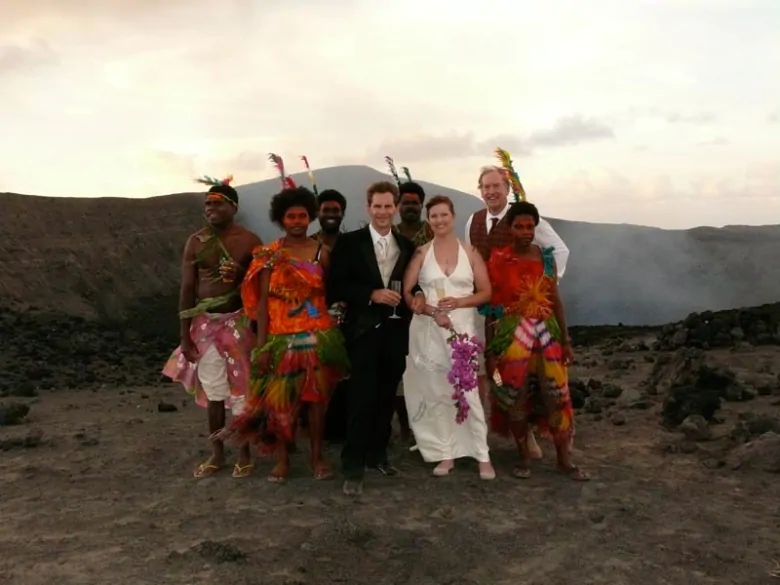Volcano tourism: Bad idea or a worthy risk-taking adventure?

George Kourounis and his wife Michelle were married atop an erupting Mount Yasur in Vanuatu in 2006.
As they exchanged wedding vows, video captured steam and rock being blown out from the volcano’s lake of lava below — and not that far off in the distance.
In light of the recent tragedy in New Zealand, where a volcano on White Island recently erupted, killing at least eight people and injuring more than 30, it might seem like a frivolous and needless risk to take.
But this is what Kourounis does for a living: The Toronto man is an extreme adventurer. He chases hurricanes and tornadoes, and he visits — and sometimes conducts tours of — volcanoes.
He’s descended the Marum crater on Ambrym Island in Vanuatu, burned his shoes at Kilauea in Hawaii, and watched lava bombs explode near the edge of the Italian volcano Stromboli in the Tyrrhenian Sea.
Kourounis knows there’s danger involved, but to him, it’s worth it.
“I’m fascinated by Mother Nature, and particularly the extremes of Mother Nature. I think those are the things that compel people,” said Kourounis.
But he added: “In all these years of doing this, I understand — fully — that things can go pear-shaped pretty quickly.”
Not all volcanoes are equal
Since the White Island eruption, questions have been raised as to whether people should have been allowed to visit the privately owned island after the alert level had been raised to 2 (on a scale of 0 to 5) by GeoNet, New Zealand’s geological hazard monitoring agency. The tour went on despite that.

Volcanologist Erik Klemetti, of Denison University in Granville, Ohio, told CBC News that he has specifically avoided White Island.
“White Island is tricky,” he said. “As a volcanologist, I felt like it was sort of my duty to not feel like I should support tour operations that are going to potentially put people in danger like that.”
But Kourounis, who has been to White Island himself, says that though the area is fairly active, there are other spots that are far more active, where people live and visit, like Italy’s Mount Etna on the island of Sicily.
“There’s a ski hill on Mount Etna,” he said. “There’s a gondola that has been destroyed numerous times by a volcanic eruption.”

Not all volcanoes are created equally.
People know to expect regular eruptions from Etna. But volcanoes that are only mildly active might take people by surprise, as White Island did on Monday.
“Each volcano has a different personality,” said Kourounis. “It’s the quiet ones you have to be careful of.”

While scientists may be able to tell that an eruption may occur, monitoring tremors produced by pressure and movement, volcanoes and their activity vary widely.
“There are a lot of styles of volcanic eruptions, and some of them come really without warning,” said Klemetti. “It could be a steam-driven explosion [where] there aren’t really any signs ahead of times.”
One such event, he noted, was the 2014 eruption of Japan’s Mount Ontake, where 63 people ultimately died.
That event was a phreatic eruption: steam-driven explosions that occur when water beneath the surface of a volcano (or sometimes on the surface itself) is heated by magma or hot rock. The incredible heat causes that water to boil and suddenly flash to steam, creating a powerful explosion.

But there is little to no warning with a phreatic explosion — and some believe this may be what occurred on White Island.
“White Island has a crater lake in the summit, in the area where people tour, so there’s a lot of water. And if that water gets into the volcano, it can blast into steam,” said Klemetti.
A history of extreme tourism
People have had a long history of wanting to visit potentially dangerous, yet fascinatingly beautiful sites, Kourounis notes.
Yellowstone National Park, for example, is home to a quiet supervolcano in Wyoming — and it was the first national park established in the U.S. in 1872.

New Zealand also has one of the oldest national parks in the world, Tongariro National Park, established in 1887, where there are three active volcanoes.
“People love to visit places like [White Island]. It’s this little spot of land where you can seemingly go back in time millions of years and see the process that formed the Earth. And most people don’t get to see that,” Kourounis said.
“So here was this little place … you take a boat ride out there, and suddenly you’re on what seems to be another planet. You visit for a couple of hours and then you leave. You take that experience away with you — and it’s fascinating.”
There are ways to make such excursions safer, he said, including re-examining if tours should visit sites that are at a Level 2 on the eruption scale.
Kourounis himself has a steadfast rule: “Risk equals proximity times time.” So reducing your time in the area and keeping your distance can minimize your risk.
Still, he knows that as an extreme adventurer, he’s often putting his life at risk. And it’s something that people taking these tours should also realize, he says, though, “you never think it’ll happen to you.”
After 21 years of extreme travel, Kourounis says he’s happy to report he’s never had a broken bone or an overnight stay at a hospital. But he also acknowledges that he has no control over what happens.
“Mother Nature is in control,” he said.” And if she decides today’s the day, today’s the day.”





